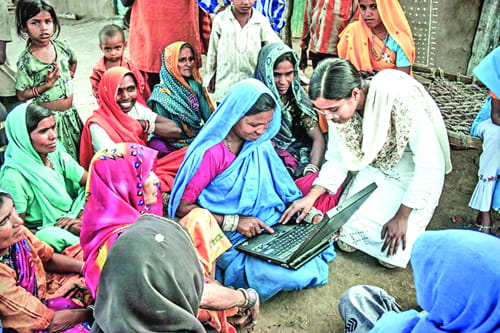Unveiling the Empowerment Equation: Affirmative Action for Women in India-Real Progress or Illusion?

Dr. Alka Sharma
Affirmative action refers to the procedures or policies aimed to eliminate unlawful discrimination and to increase opportunities for women. In India, it has been a pivotal aspect of the empowerment equation, aiming to bridge gender disparities and foster inclusivity. Empowerment equation is to provide representation to women that contribute to increasing their abilities to take control of their life and make impactful decisions. The dire need of the hour is to delve into the effectiveness of such measures, questioning whether the progress achieved is tangible or merely an illusion. It is pertinent, first of all, to comprehend the dynamics of affirmative action in India. Initiatives like reservations in education and employment have been implemented to address systemic gender imbalances and provide women with equal opportunities. The Government initiatives viz. Beti Bachao Beti Padao, Sukani,ya Samridhi Yojana provide financial assistance for health and education of the girl child. Scholarship schemes like AICTE Prapati scholarship,etc. are given to the families with less than income of 8 lac per annum for girls studying in first year technical courses and awards & cash of 50,000 per annum and other benefits are also provided. According to Equal Renumeration Act,1976 payment of equal renumeration to men and women is to be provided. Maternity Benefit Act, 2017 facilitated women with paid maternity for 12-26 weeks. Even mandatory crèche facility makes it possible for women to put in their best efforts even at their work place and give out best results.The various progress indicators include examining educational attainment, workforce participation, and leadership roles for women. Highlighting success stories and notable achievements shed light on the positive impact of affirmative action in specific spheres. The economic aspect of women’s empowerment is a critical dimension. Analyzing the economic status of women post-affirmative action measures can unveil whether financial independence has genuinely materialized or if there are persisting gaps. The schemes like STEP – a Central Sector Scheme launched in 1986-87, seeks to upgrade the skill of poor and assetless women and provide employment on a sustainable basis by mobilizing them in viable cooperative groups, strengthening marketing linkages, support services, and access to credit.Programs like National Rural Livelihood Mission (erstwhile SGSY) of MoRD, Smayamsidha of MWCD and similar programs of other Ministries and organizations would need to be converged to help the identified Self Help Groups in a coordinated fashion. Besides this, women are becoming even the voice of various sections of our society. To increase their participation in the political sphere, amendments like 73rd & 74TH have been made which reserved one-third seats for women in Panchayats and Urban Local Bodies.They are getting representation in decision-making bodies. Evaluating whether affirmative action has translated into increased political participation and influence is vital for gauging its efficacy.Considering the diverse cultural landscape of India, societal attitudes play a significant role in shaping the success of affirmative action. Understanding how cultural norms either facilitate or hinder progress is crucial in forming a comprehensive perspective.Despite affirmative action, women in India still encounter myriad challenges, ranging from societal norms to workplace biases. Unraveling these obstacles is crucial to understanding the nuances that hinder the complete realization of empowermentQuantifying the impact of affirmative action involves examining statistical data, conducting surveys, and seeking feedback from beneficiaries. A nuanced evaluation helps discern whether these measures have genuinely empowered women or if challenges persist.Hence, it may be concluded that the empowerment equation in India, fortified by affirmative action for women, embodies both progress and challenges. By scrutinizing various facets – education, employment, economics, politics, and cultural dynamics – this article strives to unravel whether the strides made are real or if an illusion of empowerment prevails. The quest for gender equality continues, navigating the complex terrain of societal norms and policy effectiveness.
(The author is an educationist).
